Recalling
September 11th
by Anthony Correia
Staff Photographer
Queens Chronicle
www.anthonycorreia.com
This is my memory of September 11th…
I was on my way to work that day… September 11, 2001, as were
many other people. The difference was that I worked close to lower
Manhattan and I was a working news photographer. I managed the Reuters
News Picture Collection at Archive Photos (known as ‘the Archive’ to
Reuters photographers) that was slowly becoming a part of Hulton Archive
under the auspices of Getty Images. (The Reuters News Picture Collection
eventually moved to another agency in New York City named
Landov, but that is another story…) I also
worked for a local community newspaper called The Queens Chronicle
at the time too.
The local 1/9 train I was on overshot my local Canal Street station
stop, as usual, that morning. Sometimes the train stayed local, as
it was supposed to, but most times I was forced to go express to Chambers
and then transfer back uptown, one stop, to Canal. This was a small
part of my normal daily morning commute.
In the subway tunnel, between Canal and Chambers, my train stopped
abruptly. A few minutes after the sudden stop, the conductor came
online and announced that a ‘small plane had hit one of the Twin Towers.’ There
was no communication at all after that for close to 45 minutes. Everyone
on the train was pretty calm and kind of speculated as to what was
happening above us, less than half a mile away. Personally, it was
hard to believe that a plane had actually hit the World Trade Center
and that I was stuck underground, so close by without being able to
document it… yet.
Without warning, the train started to move very quickly and went
express straight to 14th Street Union Square. As we arrived at the
station,
we were advised to go to the surface and head home. Once I made it
to street level I saw a lot of smoke coming from the World Trade
Center area and knew that what the conductor had announced was really
true.
The amount of smoke, however, had me thinking that it was more than
just a ‘small plane’ and I began walking quickly towards
the West Side and then south heading straight to the area now known
as ‘Ground Zero.’ I was not heading home.
As I made my way downtown, I had no idea that one of the Towers had already
collapsed and the other was close to coming down too. A lot of people
were walking and just standing around, not knowing what to do. I kept
walking straight down Hudson St, past my office on Canal. I encountered
my first police barricade that day, a few blocks south of Canal. I
didn’t stop walking as I approached the barricade. My credentials
were out and I just loudly said, ‘press’ to get past. The
female cop looked like a rookie and scared to be where she was. |

NEW
YORK - SEPTEMBER 11: New York City firefighters
and journalists stand near the area known as Ground
Zero after the collapse of the Twin Towers September
11, 2001 in New York City.
© Photo
by REUTERS/Anthony Correia
|
|
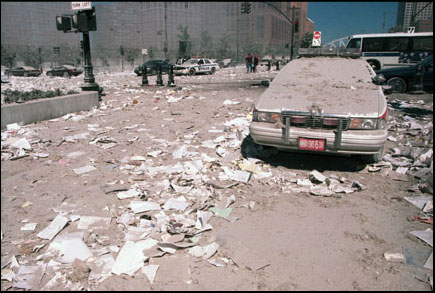
NEW YORK - SEPTEMBER 11: A New York City Fire Department
(FDNY) vehicle lies covered with dust and ash near the area
known as Ground Zero after the collapse of the Twin Towers
September 11, 2001 in New York City.
© Photo by Anthony
Correia
|
|
I began
shooting after crossing that first barricade. It looked like
it had snowed on that blue sky day. ‘White stuff’ was
all over the place and the air was full of it too. People were
getting scarcer and scarcer. I began noticing that the people
I did see were wearing face masks and walking quicker than usual,
away from the World Trade Center area. |
| |

NEW YORK
- SEPTEMBER 11: Pedestrians walk along a dust and debris
covered West Side Highway (Joe DiMaggio Highway) near
the area known as Ground Zero after the collapse of the
Twin Towers September 11, 2001 in New York City.
© Photo
by Anthony Correia |
|

NEW YORK - SEPTEMBER 11: A New York City firefighter leaves
the area known as Ground Zero after the collapse of the Twin
Towers September 11, 2001 in New York City.
© Photo by
Anthony Correia |
|
As I walked
closer to where the Towers should be, in what was absolutely
choking air, I kept encountering tighter and stronger police
barricades.
I kept bypassing these barricades by simply walking around the
block where there was no police presence and eventually made
it to the West Side Highway (Joe DiMaggio Highway), near Stuyvesant
High School and the Borough of Manhattan Community College (BMCC).
I was having difficulty breathing at that point and it was a
literal ‘no man’s land’ too. The only people
I saw at that point were emergency personnel and people who were
slowly walking away from the area, seemingly, in shock. |
I was having trouble breathing
when I noticed an unmanned bagel cart across the street from the
school and I reached in to get a
handful of napkins. Those napkins helped me breath as I kept them over
my mouth
and nose from that point on. I only removed them, holding my
breath at times, to take a picture or swap out a roll of film.
Yes, I
was still shooting film back then. I always carried my gear with
me, wherever I went: a Canon EOS 1V HS with 28-70 f/2.8L lens & a
550EX flash. That was my ‘carry around’ gear at the
time. I always carried plenty of film with me (or so I thought),
but that day I was stuck with a few 12 exposure rolls of cheap
film that I used for test shots or small assignments and one
24 exposure roll (not a lot of film at all, really). The biggest
assignment of my life (I thought) and I only had a few rolls
of film on me. I went digital soon after, buying my first Canon
EOS 1D with plenty of CF cards.
Realizing how low a supply of film I actually had on me, I shot as selectively
as I could. Whenever I swapped out a roll of film, it was very hard, if not impossible,
to keep dust out of the camera, so I would do it as quickly as I could with my
back to the wind/dust. Small particles of dust lingered in the air, on the ground
and all over me too.
|
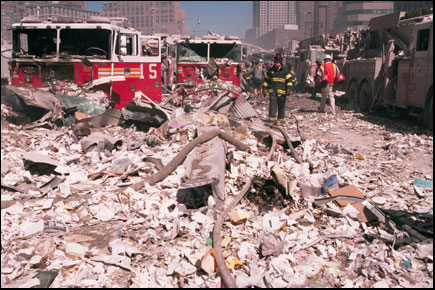
NEW YORK
- SEPTEMBER 11: A New York City Fire Department vehicle
lies covered with dust and ash near the area
known as Ground Zero after the collapse of the Twin Towers
September 11, 2001 in New York City.
© Photo
by REUTERS/Anthony Correia |
|
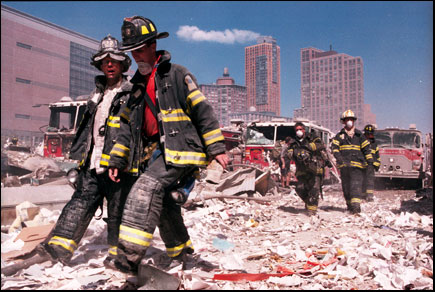
NEW YORK - SEPTEMBER 11: New York City firefighters walk
towards the area known as Ground Zero after the collapse
of the Twin Towers September 11, 2001 in New York City.
© Photo
by REUTERS/Anthony Correia |
|
As I kept
getting closer to Ground Zero, smoke, debris and dust covered
the area. I had never experienced anything like this and thought
to myself, as I brought my camera down from my face, “this
is a f**king war zone.” I could not believe what I was
seeing and capturing on film. I kept looking up, trying to see
the Towers, thinking they were just on fire (I could not fathom
that they could come down). As I kept getting closer, now along
Greenwich Street, walking around the next corner, I thought to
myself that I should be able to see them, despite all the smoke.
As a native New Yorker those Towers have always been around,
helping me orient myself in the big city and now I realized that
they were ‘gone.’ |
I walked
as close to Ground Zero as I could (Building #7) before running
out of film. I looked around a little bit more, facing the reality
that I had no more film, and began walking away from the area.
I wanted to get my film processed as quickly as possible and
had to find a lab.
As I walked uptown, every shop where I tried to get my film processed was either
closed, backed up with other people’s film or charging jacked up prices
to process… I am talking about 400% in some instances! |
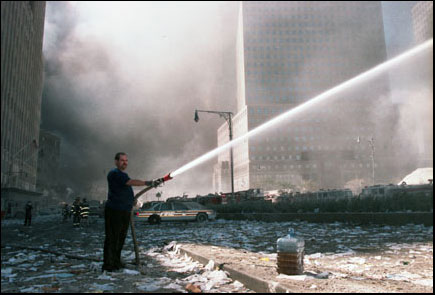
NEW YORK - SEPTEMBER 11: An unidentified civilian waters
down the area with a firehose near the area known as Ground
Zero after the collapse of the Twin Towers September 11,
2001 in New York City.
© Photo by Anthony Correia |
|
I found a small shop
just north of Houston that was able to process my film at a normal
rate. When I saw what I had, I tried
to figure out what to do next. Since I was working for Archive
Photos (Getty Images), I first tried to contact their editorial
desk, but I could not get through. I tried to get into
the main office on Varick, but building personnel would not let
me in as the building was officially ‘
evacuated.’ Police were starting to get riled up, barking orders
at anyone who would listen. I could not get
to my home in Queens and I was getting tired. Fed up, I started walking
straight
up Sixth Avenue
towards Times Square…
After touching base with some family members, letting them know I
was safe, I tried calling the NY Reuters office. I could
not get through
there at all. I called and got through to a
friend/colleague in the Reuters’ Washington, DC office, Molly
Riley.
She was happy to hear my voice, and know that I was ok. When
I explained to her that I was downstairs at her NY office,
she told
me to wait there until someone could come down for me.
Jeff Christensen came down and cleared me through security.
As one could imagine, the phones were ringing off the hook and the
televisions were all focused on what was happening downtown.
I sat down and helped cover some phones while scanning some of my
negs. After
I was through scanning and captioning, Jeff edited my take
and decided to run a few over the wire. Being able to contribute
to the collection
that I had taken care of for almost three years, up to that
point, was a good feeling.
A young couple had come by and asked building security if they could
speak with a Reuters editor, to show their work for possible
use. Jeff asked me to go downstairs, see what they had and ‘help
them out.’ When
I met the couple downstairs, they were pretty worked
up, telling me about their day and just pouring out their
feelings to me. As we spoke,
I began to review their material. I forget the exact
count, but they had developed a lot of film that day. When
I say a lot, I was at a
loss for words at what they wanted me to look at (maybe
25-30 rolls of prints/film). I started to look at their prints
and, at the same
time, tried to verify where the negs were too because
some of the prints were not matching up with the negs. After
quickly editing their take,
I asked them if I might bring a few prints upstairs for
consideration. After showing my edit to Jeff, he asked me
to bring the young couple
and their material upstairs in order to have a contract
signed. I left the office shortly after their pictures were
transmitted over the wire
that evening. Much later, I learned that one of those
pictures that I helped edit ended up being used in the book “September
11: A Testimony.” I don’t recall the photographer’s
name, but the Reuters image shows a person pointing towards
smoke as one
of the towers collapses.
As I began to try to get home that night, everything was starting
to go into lockdown mode in regards to public transportation in NYC.
On September 12th, I found out that I had an involuntary ‘vacation’ from
work when I tried to get to my office again. My office, at the
time, was located just below Canal and police/military were not allowing
anyone past checkpoints at Canal…. especially not members of
the press (which is another topic altogether). No one knew how long
it would take at the time, but my ‘time off’ ended
up to be about two weeks.
After not being able to get to my regular job, I made my way back
uptown to the Reuters office. I had to be useful, somewhere. That
day, after
speaking/working with him for a few years, I finally met
Gary Hershorn in person. He put me to work quickly. I helped coordinate
a pool with
the AP that day. After that assignment, I recall hearing
editors and photographers start to talk about a picture taken by
Shannon Stapleton.
His image showed an injured person being helped out of the
rubble area of Ground Zero, but no one had a positive ID on that
victim. Rumor
had it that the person was a member of the New York City
Fire Department (FDNY). I offered to go around to local firehouses
in the area to try
to get an ID. On the fourth try, I was able to get one. The
injured person turned out to be Father Mychal Judge, a FDNY chaplain
who died
on September 11th. The caption was eventually revised after
another confirmation and the image was sent out again, over the wire.
About six months after September 11th, checkpoints started to relax
and people were able to start walking around the area,
somewhat normally (but not, really, as people could not take pictures
of the area… still
another story in the making). As soon as I could, I decided
to try and retrace my initial route to Ground Zero. It was
initially hard
for me to do, but I had to do it and I did.
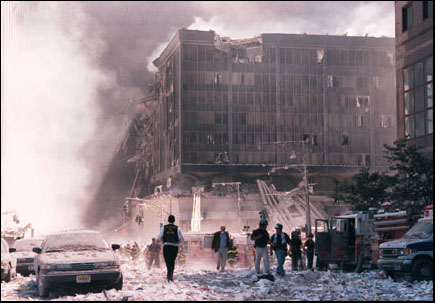
NEW YORK - SEPTEMBER 11: New York City firefighters and
other emergency personnel stand near the area known as Ground
Zero after the collapse of the Twin Towers September 11,
2001 in New York City.
© Photo by Anthony
Correia |
|
As the anniversary of September 11th approaches,
let us pray & be vigilant that a tragedy like what occurred that
day does not ever happen again.
|









